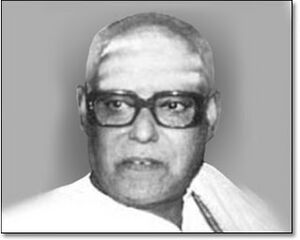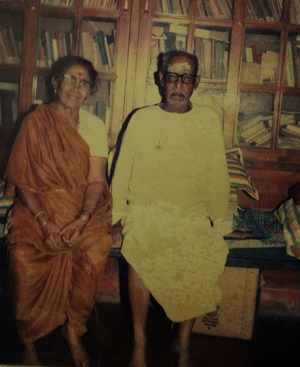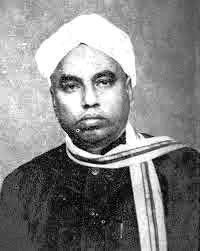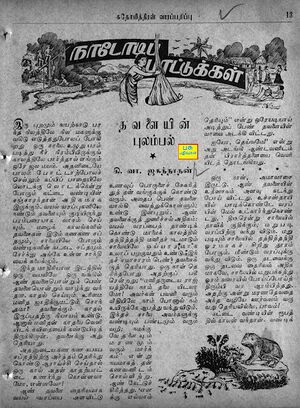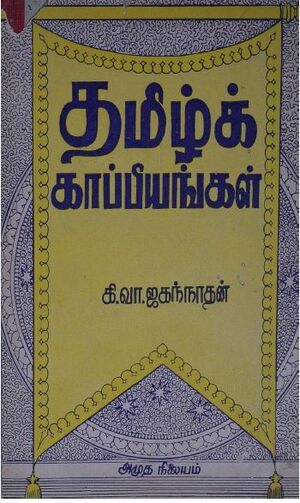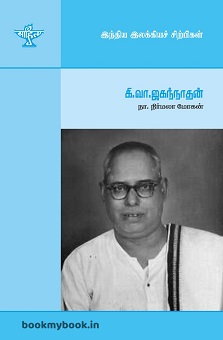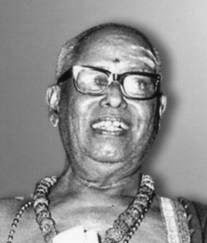Ki.Va. Jagannathan: Difference between revisions
No edit summary |
No edit summary |
||
| Line 6: | Line 6: | ||
== Birth, Education == | == Birth, Education == | ||
Ki. Va. Jagannathan was born on April 11, 1906 in Krishnarayapuram, Karur district, to Vasudeva Iyer and Parvatiyammal. Soon, the family moved to Mohanur, near Salem. He received his primary education in a ''thinnaipalli'' (porch). He continued his education in schools in Vangal and Kulithalai. He could not complete his higher education since he had a stroke. Later, he started reading books by himself; visiting the Tilakar Library in Mohanur to read on a regular basis. | Ki. Va. Jagannathan was born on April 11, 1906 in Krishnarayapuram, Karur district, to Vasudeva Iyer and Parvatiyammal. Soon, the family moved to Mohanur, near Salem. He received his primary education in a ''thinnaipalli'' (porch). He continued his education in schools in Vangal and Kulithalai. He could not complete his higher education since he had a stroke. Later, he started reading books by himself; visiting the Tilakar Library in Mohanur to read on a regular basis. | ||
[[File:Pic-2.jpg|thumb| | [[File:Pic-2.jpg|thumb|Ki. Va. Ja]] | ||
At the age of 22, Ki. Va. Jagannathan spoke at a festival held in Gandhamalai Murugan Temple; Senthamangalam Swayam Prakasa Swamigal, also known as Kichu Udayar, after hearing his speech, asked him to stay and work in the town. While he worked as an accountant in the panchayat office, he gave lectures and taught lessons to the children of an ashram. He also taught Tamil to an Englishman named Drover, whom Swamigal introduced to him. | At the age of 22, Ki. Va. Jagannathan spoke at a festival held in Gandhamalai Murugan Temple; Senthamangalam Swayam Prakasa Swamigal, also known as Kichu Udayar, after hearing his speech, asked him to stay and work in the town. While he worked as an accountant in the panchayat office, he gave lectures and taught lessons to the children of an ashram. He also taught Tamil to an Englishman named Drover, whom Swamigal introduced to him. | ||
| Line 15: | Line 15: | ||
== Personal life == | == Personal life == | ||
[[File:Ki va jagannathan large.jpg|thumb| | [[File:Ki va jagannathan large.jpg|thumb|Ki. Va. Ja]] | ||
Ki. Va. Jagannathan married Alamelu in 1932. In 1932, he was offered to work as a sub-editor at ''Kalaimagal'' magazine. He joined and continued as an editor at ''Kalaimagal'' magazine until the end of his life. | Ki. Va. Jagannathan married Alamelu in 1932. In 1932, he was offered to work as a sub-editor at ''Kalaimagal'' magazine. He joined and continued as an editor at ''Kalaimagal'' magazine until the end of his life. | ||
Revision as of 20:31, 18 March 2022
இந்தப் பக்கத்தை தமிழில் வாசிக்க: கி. வா. ஜகந்நாதன்
Ki. Va. Jagannathan (Ki. Va. Ja) (April 11, 1906 - November 4, 1988) was a Tamil scholar, journalist, folklorist, and literary critic. He was a student of U.V. Swaminatha Iyer and the editor of Kalaimagal Magazine.
Birth, Education
Ki. Va. Jagannathan was born on April 11, 1906 in Krishnarayapuram, Karur district, to Vasudeva Iyer and Parvatiyammal. Soon, the family moved to Mohanur, near Salem. He received his primary education in a thinnaipalli (porch). He continued his education in schools in Vangal and Kulithalai. He could not complete his higher education since he had a stroke. Later, he started reading books by himself; visiting the Tilakar Library in Mohanur to read on a regular basis.
At the age of 22, Ki. Va. Jagannathan spoke at a festival held in Gandhamalai Murugan Temple; Senthamangalam Swayam Prakasa Swamigal, also known as Kichu Udayar, after hearing his speech, asked him to stay and work in the town. While he worked as an accountant in the panchayat office, he gave lectures and taught lessons to the children of an ashram. He also taught Tamil to an Englishman named Drover, whom Swamigal introduced to him.
Sri Sivasanmuga Meignana Sivachariyar visited Senthamangalam, Ki. Va. Ja. sent a letter of request to learn Tamil further from him. He advised Ki. Va. Jagannathan to go to U. V. Swaminatha Iyer to further learn Tamil. U. V. Swaminatha Iyer was working as a Tamil teacher in Chidambaram during that time. Ki. Va. Jagannathan went to Chidambaram and conveyed his interest to U. V. Swaminatha Iyer. U. V. Swaminatha Iyer was planning to go to Pachaiyappa’s College in Chennai as a Tamil teacher and asked Ki. Va. Jaganathan to accompany him to learn Tamil. Ki. Va. Jagannathan went to Chennai along with U. V. Swaminatha Iyer and stayed at his home. He learnt Tamil literature from U. V. Swaminatha Iyer, and assisted him with his publications and research.
Under the guidance of U. V. Swaminatha Iyer, Ki. Va. Jagannathan wrote the Tamil Pulavar examination and ranked first in the state. He also won a prize of one thousand rupees from Thiruppanandal Adheenam.
Personal life
Ki. Va. Jagannathan married Alamelu in 1932. In 1932, he was offered to work as a sub-editor at Kalaimagal magazine. He joined and continued as an editor at Kalaimagal magazine until the end of his life.
Literary life
Ki. Va. Jagannathan started writing poems at the age of 14. He wrote a Cheiyulkovai about the Chidambaram Natarajar titled Pottripathu; it was his first work. His poems under the pseudonym Jyoti were published in literary magazines of the time in Tamil Nadu. He was interested in the independence movement and believed in Gandhism. He wore khaddar until his last day. He wrote poems such as Suthanthradevi Tiruppalliyeluchi and Suthanthradevi Thirukoil.
He wrote a Tamil literature quiz under the pen name Vidayavan, it was a serialized publication in Kalaimagal magazine.
Assistance in U. V. Swaminatha Iyer’s research
He helped with U. V. Swaminatha Iyer’s research. In the preface of U. V. Swaminatha Iyer’s Thakkayaaga Barani novel, he mentioned that “In the days that this book was being tested and printed, Ki. Va. Jagannathan, a Tamil scholar from Mohanur, fondly helped in the writing, research, and analysis of this book”. He has written short stories, poems, and stories for the Kalaimagal magazine as well.
Ki. Va. Jagannathan helped in writing and publishing U. V. Swaminatha Iyer’s autobiography En Sarthiram, and Sri Meenakshi Sundharampillaivargal Sarithiram. En sairithiram was serialized in Anandha Vikatan. However, U. V. Swaminatha Iyer passed away before the series ended. As per the notes written by U. V. Swaminatha Iyer, it was known that Ki. Va. Jagannathan had written the rest of the book and published it. Ki. Va. Jagannathan wrote a book about U. V. Swaminatha Iyer titled En Aasiriyapiraan.
Tamil Research
Ki. Va. Jagannathan reviewed and checked the texts of Thirukkural and published it as a single novel titled Thirukkural Vilakku. He wrote explanatory texts and introductions to books such as Thevaram, Thiruvasagam, Thiruppugazh, and Periyapuranam.
Folklore
Ki. Va. Jagannathan is considered one of the pioneers in Tamil folklore. He met Devendra Satyarthi, a researcher who had collected folklore all over India; Ki. Va. Jagannathan was inspired and decided to do the same. He travelled to villages, collecting and compiling folk songs and proverbs. It was through him that folklore in Tamil was systematically compiled and published. In the preface of his Theivapadalgal (hymns), he mentioned, “Usually women sing these songs, but they will refuse to sing them if we request it. However, if we start singing by ourselves, they will sing along without any inhibitions. I used this strategy to make them sing.”
Ki. Va. Jagannathan refers to folk literature as nomadic literature because it is orally transmitted and not rooted in a place. It is remarkable that he, a scholar in traditional verse poetry, was involved in folklore and folk literature during the Tamil Renaissance period, which predominantly focused on classical literature. Ki. Va. Jaganathan contributed to folk literature like how U. V. Swaminatha Iyer contributed to classical literature. The period in which he collected them is also significant; it was the time in which traditional education and rural life were coming to an end while modern education and migration towards the city began. A part of folk literature could have been destroyed if he hadn’t made an effort at that time. Nadodi Illakiyam, Tamizhaga Naatupura Padalgal, Thirumnapadalgal, Theivapadalgal and, Tamizhaga Pazhamoligal are his important novels. Ki. Va. Jagannathan has collected twenty-two thousand Tamil pazhamoligal (proverbs).
Journalism
Ki. Va. Jagannathan was the editor of Kalaimagal for 53 years, from 1932 until his death. The Manikkodi writers: Pudhumaipithan, Na. Pichamoorthy, Ku. Pa. Rajagopalan continually wrote for Kalaimagal. Writers of the time, such as Akilan, Pi. Vi. Aar, and R. Vi were introduced through the Kalaimagal magazine. Female writers like R. Chudamani, Rajam Krishnan, and Anuthama were also introduced through Kalimagal when it was turned into a family magazine. Kalaimagal created a panel of female writers. Writer Ambai was also introduced through Kalaimagal. Kalaimagal's contribution to Tamil literature is paramount.
Awards
- In 1967, he was awarded the Sahitya Akademi Award for his literary criticism work of Veerar Ulagam.
- He has received numerous titles: Vagisa Kalanidhi, Senthamizhselvar, Tamil Perumbulavar, Thiruneri Thavamani, Sollin Selvar.
- In 1982, he received the Raja Sir Annamalai Chettiar Ninaivu Parisu.
Death
Ki. Va. Jagannathan passed away on November 4, 1988, in Chennai.
Memory, biography
- The Kamban Kazhagam has been providing gifts in Ki. Va. Ja’s memory.
- Ki. Va. Jagannathan's biography, written by Nirmala Mohan, has been published by Sahitya Akademi in the Indhiya Illkiya Sirpigal series.
Works
Ki. Va. Jagannathan has written more than 150 books.
Folklore
- Ettra paatugal
- Nadodi Illakiyam
- Tamil Nadodi Padalgal
- Tamil Pazhamoligal - Thogudhi 1
- Tamil Pazhamoligal - Thogudhi 2
- Tamil Pazhamoligal - Thogudhi 3
- Tamil Pazhamoligal - Thogudhi 4
- Theivapadalgal
- Thirumanapadalgal
- Malaiaruvi
Literature
- Adhikaman Neduman anji
- Appar Thevara Amudhu
- Abirami Anthadi
- Abirami Anthadi vilakkam
- Amutha Ilakiya Kadhaigal
- Azhiya Azhagu
- Arapor- Sanganoor Katchigal
- Ratnagiri Balamurugan Anthadi
- Inpamalai - Sanganoor Katchigal
- Ellam Tamil
- Ezhil Udhayam
- Ezhu Peruvazhalgal
- Olivalar Vilakku
- Kanni Tamil
- Kaarakaalamaiyaarin Arpudha Thiruvandhadhi
- Kaviyamum Oviyamum
- Kovur Kilar
- Sagala Kalavalli
- Sankara Rasendra Cholan Ula
- Saranam Saranam
- Chithi Vezham
- Tamil Nool Arimugam
- Tamil Vaiyai - Sanganoor Katchigal
- Tamil Kaapiyangal
- Thamarai Poigai- Sanganoor Katchigal
- Thirattu paal
- Thiru Ammanai
- Thirukural Vilakku
- Thirukolam
- Thirumurukattrupadai
- Thirumurukattrupadai- pozhipurai
- Thiruvembavai
- Theiva Paadalgal
- Thevaram-Yezham Thirumurai
- Pudhuvellam-sanganoor katchigal
- Periya Purana Vilakkam Pagudhi-1
- Periya Purana Vilakkam Pagudhi-2
- Periya Purana Vilakkam Pagudhi-3
- Periya Purana Vilakkam Pagudhi-4
- Periya Purana Vilakkam Pagudhi-5
- Periya Purana Vilakkam Pagudhi-6
- Periya Purana Vilakkam Pagudhi-7
- Periya Purana Vilakkam Pagudhi-8
- Periya Purana Vilakkam Pagudhi-9
- Periya Purana Vilakkam Pagudhi-10
- Perum Peyar Murugan
- Pandian Nedunjezhiyan
- Paari Vel
- Vazhum Tamil
- Vidayavan Vidaigal
- Manai Vilakku- sSnganoor Katchigal
- Maalai Poonda Malar
- Muneer Vizha
- Murugan Anthadi
- Mullai Manam
- Tamizhppa Manjari
- Kumana vallal
Biography
- En Aasiriyapiraan
- Tamizh Thaatha (U.V. Swaminatha Iyer)
General
- Anuboodhi Vilkkam
- Arundha Thandhi
- Adhisaya Pen
- Anbin Uruvam
- Anbu Maalai
- Atma Jyoti
- Aramba Arasiyal Nool
- Aalaikarumbu
- Iruvilangu
- Ilangai Kaatchigal
- Udhayam
- Ullam Kulirndhadhu
- Ondrae Ondru
- Kanjiyilum Inbam
- Kandariyadhana Kandaen
- Kadhirakama Yathirai
- Kadhai Sollugirar Ki. Va. Ja
- Karikal Vallavan
- Kalaiselvi
- Kalaigan Thiyagam
- Kavi Padalam
- Kavignar Kadhai
- Karpaga Malar
- Pidiyum Kalirum- Sanganoor Kaatchigal
- Naayanmar Kadhai
- Kizhaviyin Thandhiram
- Kumariyin Mookuthi
- Kuzhandhai ulagam
- Kurunji Thaen
- Koyil Mani
- Sirika Vaikiraar Ki. Va. Ja
- Silambu Pirandha Kadhai
- Sitrambalam Sudhandhirama!
- Gnyana Maalai
- Tamil Naavalgal- Naval Vizha Karuthuraigal
- Tamil Naavilin Thotramum Valarchiyum
- Tamizhin Vetri
- Naam Arindha Ki. Va. Ja
- Naayanmar Kadhai- Mudhal Pagudhi
- Naayanmar kadhai-Irandam Pagudhi
- Thani Veedu
- Thaenpaagu
- Nalla Senapadhi
- Nalla Pillayar Navakragam
- Naal Pazhangal
- Bayapudadheergal Ki. Va. Ja
- Pala Kadhambam
- Palvagai Paadalgal
- Pavala malligai
- Paarkadal
- Palar Ezhuthiya Sirukathaigal
- Pinnu Senjadai
- Pugazh Maalai
- Pudhu Diary
- Pudhu Merugu
- Pesadha Pecchai
- Pesadha Naal
- Moonru Thalaimurai
- Megamandalam
- Valikati Valai Chetti-Sirukadhaigal
- Vaarungal Parkalam
- Vazhkai Suzhal
- Vilayum Payir
- Veerar Ulagam
Texts
- Kandharalangara Sorpolivugal Paagam-1
- Kandharalangara Sorpolivugal Paagam-2
- Kandharalangara Sorpolivugal Paagam-3
- Kandharalangara Sorpolivugal Paagam-4
- Kandharalangara Sorpolivugal Paagam-5
- Kandharalangara Sorpolivugal Paagam-6
- Ki. Va. Ja. Pesugirar
- Ki. Va. Ja-vin Siladaigal
